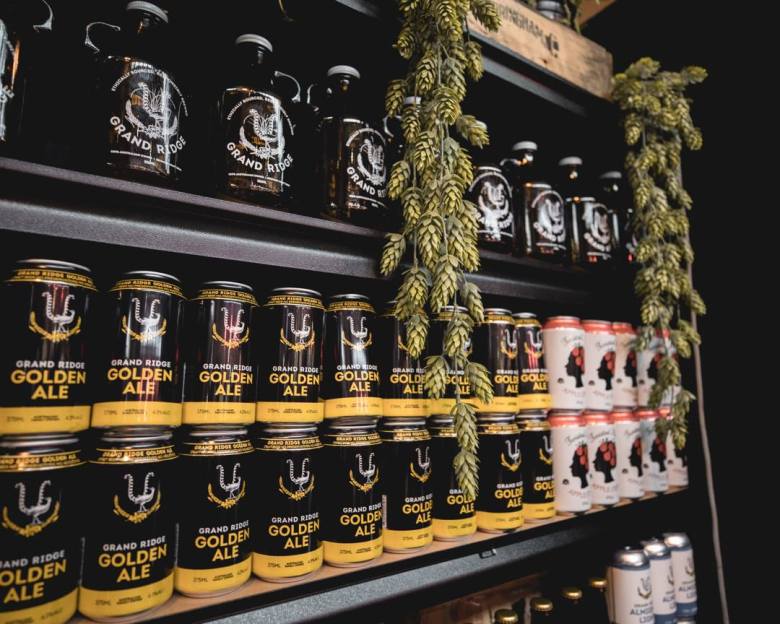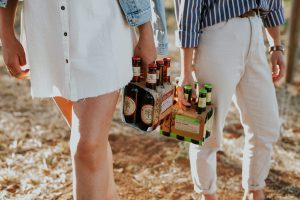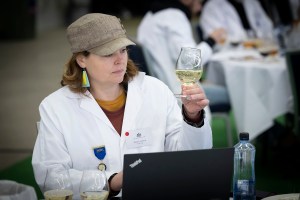 With an approachable taste and lower ABV, XXXX Ginger Beer was designed for customers seeking a "near beer" alternative.
With an approachable taste and lower ABV, XXXX Ginger Beer was designed for customers seeking a "near beer" alternative.  With an approachable taste and lower ABV, XXXX Ginger Beer was designed for customers seeking a "near beer" alternative.
With an approachable taste and lower ABV, XXXX Ginger Beer was designed for customers seeking a "near beer" alternative.  With an approachable taste and lower ABV, XXXX Ginger Beer was designed for customers seeking a "near beer" alternative.
With an approachable taste and lower ABV, XXXX Ginger Beer was designed for customers seeking a "near beer" alternative.  Brunswick brewery Keeper Brewing is continuing its focus on crafting one style of beer, the Pilsner, as the category grows in demand.
Brunswick brewery Keeper Brewing is continuing its focus on crafting one style of beer, the Pilsner, as the category grows in demand. (Denver, CO) —The Brewers Association (BA) revealed the top beers and ciders of 2024 at an awards ceremony during the Great American Beer Festival (GABF®). In partnership with the American Cider Association, the prestigious competition bestowed awards in five new cider categories. With more than 1,200 cider producers in the U.S., the GABF competition keeps consumer drinking […]
The post The Winners of The 2024 GABF Unveiled! appeared first on The Full Pint - Craft Beer News.
 From industrial chemistry to marketing to brewing, Esker Beer Co’s Charlie Claridge leans on his diverse experience to create award-winning beer.
From industrial chemistry to marketing to brewing, Esker Beer Co’s Charlie Claridge leans on his diverse experience to create award-winning beer.  BeerFest Australia engages more than 30 musical acts over its festivals, with Sneaky Sound System headlining the Sydney event.
BeerFest Australia engages more than 30 musical acts over its festivals, with Sneaky Sound System headlining the Sydney event.  Organiser say they want BeerFest to create lifelong memories through unique and engaging experiences.
Organiser say they want BeerFest to create lifelong memories through unique and engaging experiences.  From Irish stout to hazy pale ales, Beer & Brewer rounds up the best non-alcoholic beers for Dry July.
From Irish stout to hazy pale ales, Beer & Brewer rounds up the best non-alcoholic beers for Dry July.  Capital Brewing Co has announced that it has bought one of Australia’s most renowned cider brands, Batlow Cider.
Capital Brewing Co has announced that it has bought one of Australia’s most renowned cider brands, Batlow Cider.  This week I look at methods to reduce oxygen in your finished beer. Oxygen is known to negatively impact beer flavor and long term stability. While oxygen is widely used at the beginning of fermentation to aid in yeast growth, the yeast effectively scrubs virtually all of the oxygen out of the beer during fermentation. […]
This week I look at methods to reduce oxygen in your finished beer. Oxygen is known to negatively impact beer flavor and long term stability. While oxygen is widely used at the beginning of fermentation to aid in yeast growth, the yeast effectively scrubs virtually all of the oxygen out of the beer during fermentation. […]  In a landmark change for the Sydney Royal Beer & Cider Show, the Royal Agricultural Society of NSW has unveiled a revamped award structure for 2024, featuring nine new major trophies and prizes.
In a landmark change for the Sydney Royal Beer & Cider Show, the Royal Agricultural Society of NSW has unveiled a revamped award structure for 2024, featuring nine new major trophies and prizes. A fun way to explore a new destination is through its local beverage scene, and many areas are making this experience even easier with the creation of beverage trails.
The post Mixed Drinks: The Lure of Beverage Trails appeared first on CraftBeer.com.
The longer I brew mixed-fermentation beers, the more I appreciate just how important the hopping rate is. Controlling lactic acid production by inhibiting lactobacillus is hops' most well-appreciated function in sour beers. Hop compounds become more effective at inhibiting Lactobacillus as the pH drops, creating a natural "limit" on their lactic acid production. What it took me a long time to appreciate was how much hop compounds (beyond IBUs) lead to a greater expression of what I think of as classic Brett "funk."
When Scott and I began the mixed-fermentation program in 2018-2019, generally our issue was beers not souring enough. I started pulling levers (lower hopping rates, higher mash temps, less attenuative primary strains etc.) By 2020-2021, we were having excessive acid production... Most non-fruited beers were dropping to a firmly-acidic 3.1-3.3 pH, while fruited beers were often difficult to drink in quantity at 3.0-3.1 pH with some dipping to "obnoxiously acidic" high-2s.
Fruit contributes simple sugars, which Lactobacillus love, and at the same time dilute the hop compounds in the beer. This can cause a precipitous pH drop. With so much beer already in barrels, my first maneuver was to begin dosing alpha acids into the beer along with fruit when there was already enough acid. We started with reduced iso-alpha-acids (e.g. tetralone/hexalone), but have moved onto Hopsteiner Alpha Extract 20% since it doesn't add perceived bitterness. About .1-.2 g per gallon stops acid production for our bacteria. These products don't significantly change the flavor or add additional aromatic complexity. As a side benefit, they enhance head retention. A small dry hop at this stage would be another option if you wanted stop acidification and add hop aromatics.
At this point we started upping the aged hop rate, or aiming for higher IBU targets when using fresh hops (~15-20 IBUs). At the same time (~2021) Scott and Ken (our head brewer) wanted to try barrel-aging more aromatically hoppy beers... I was resistant. I love hoppy-sour beers, I did a whole talk about them at the 2016 National Homebrewers Conference. Generally my approach had been to make sure the hops go into the beer as close to serving as possible (e.g., dry hop a barrel-aged sour after aging, brew a quick-turn hoppy Brett saison, add a whirlpool addition after kettle souring). I'd tasted too many barrel-soured IPAs and pale ales from great breweries that smelled like "old hoppy beer." That said, Ken and Scott convinced me! At our scale it is a relatively low risk to divert a few barrels of pale ale to see what happens.
We're already "aggressive" with our measures against oxygen pick-up (purging barrels with carbon dioxide before filling, purging the barrel-tool between each fill, purging the bottles before filling etc.), but when we fill barrels with pale ale wort we pull out all the tricks. Most importantly, we selected barrels that could be refilled without rinsing, leaving several gallons of "house culture" at the bottom of each. Our goal was to start the secondary fermentation as quickly as possible to protect the delicate hop compounds. I was amazed how good the resulting beer tasted!
What has really intrigued me is that the hoppier bases have almost universally produced finished beers I'd describe as more Brett-forward (earthy, funky, fruity, horse blanket). What I don't know is why! In American Sour Beers I cited research that Brett can free glycosides in hops, so that could explain the fruity. Maybe hops are just inhibiting Lactobacillus, giving the Brett a healthier environment (in lambics Brett tends to thrive before Pediococcus dramatically lowers the pH). Maybe I'm just being fooled and higher hopping rates (aged or fresh) are adding key compounds that I associate with the "funk" in a Cantillon, Orval (and many of my favorite American mixed-ferms)! These days our typical hopping rate is .5 lbs/bbl of aged hops at the start of the boil, and .5 lbs/bbl or fresh low alpha-acid hops in the whirlpool.
Barrels of Rings is one of the bottles included with the first shipment of the Sapwood Cellars Shipping Club. It started as Rings of Light, brewed summer 2022, racked into barrels after primary fermentation, but before dry hopping. After 10 months of aging, we transfer directly from the two wine barrels into our blending tank (purged with 5.5 pounds of our selected Citra Cryo already in there). We agitated/roused and allowed to settle for a couple days, dropping the hops. Then we primed with sugar and rehydrated wine yeast (as we do for most of our barrel-aged sours) and partially carbonated the beer. As with the barrel fill, we're relying on CO2 purging of the bottles and the rapid refermentation to scavenge oxygen and preserve hop aromatics.
Recipe: Barrels of Rings
OG: 1.063
65% Briess Brewer's 2-row
14% Great Western Malted White Wheat
13% Grain Millers Flaked Oats
8% Best Chit Malt
IBUs: 40
.5 lbs/bbl Meridian @ Whirlpool (212F)
1 lb/bbl New York Cascade @ Whirlpool (180F)
Bravo Salvo Hop Extract @ Whirlpool (180F)
Fermentation with Omega Cosmic Punch (the barrel sheet below is incorrect)
FG (Primary) 1.022
Brewed 8/5/22. Barrels filled 8/11/22
Barrel #6: Fifth-fill Chambourcin red wine barrel that previously held our original barrel-aged pale ale, Measure Twice. That barrel was started with dregs from our collab with Free Will (Erma Extra), but along the way it was filled with bases that had dregs in primary from various American saisons (Casey and Holy Mountain).
Barrel #125: Second-fill Chardonnay white wine barrel that previously held a cider fermented with the Bootleg Biology Biology Mad Fermentationist Saison (plus we added the dregs from a stellar bottle of Barrique Wet Hop Reserve after filling).
6/21/23 116 gallons of beer from the two barrels transferred onto 5.5 pounds of 2022 Citra Cryo. 1.5 oz/gallon.
Carbonated to 2.05 vol, reyeasted with Premier Cuvee (rehydrated on a stir-plate with StartUp Nutrient), primed with enough glucose to add 1.1 vol of CO2 (~3.1 vol total in bottle).
Final pH: 3.65
Final Gravity 1.009
7.1% ABV.
Tasting Notes: Barrels of Rings
(My personal notes from a few months ago)
Smell - Nice blend of citrus (orange) and earthy-Bretty-funk. Still really fresh, no oxidative or old-hop aromatics. Really varied nose with a little pine sap, hay, and melon. Another hoppy base that got funkier than most of our bases.
Appearance - Big dense white head, good retention. Light haze, very pale yellow. Attractive.
Taste - Light lemony tartness, but not sour-sour. Very saison-y. Some bitterness, but it doesn’t clash with the light bitterness.
Mouthfeel - A touch of astringency. Great sptrizy carbonation. Medium-light body.
Drinkability - Really nice. The bitterness does give it a different impression than a classic low-bitterness sour base. More saison-like.
Changes for Next Time - Really good, not much to change on this one. Gin barrels would be fun.
When visiting Epochal Barrel Fermented Ales in Scotland last year I was blown-away by how by how good (owner/brewer) Gareth Young's wild ales were aged on whole hops in the barrels for the entire secondary fermentation. I really enjoyed the first beer we did with it, Violet You're Turning Violet (Mosaic in the barrel, finished with a blend of wild and cultivated blueberries). It seems like a good option especially if you want variety in the hop intensity of a base, e.g., start with a more moderate hopped base and add hops to some barrels for blending options.
 One of Australia's oldest independent breweries has become the latest operation to look to restructure its business after 35 years of operation.
One of Australia's oldest independent breweries has become the latest operation to look to restructure its business after 35 years of operation. 
The day-long garden party will return to the Orchard Bar in Coldstream to champion Australian-grown craft cider and international guest ciders.
The post Napoleone Cider Festival returns for 2024 appeared first on Beer & Brewer.

The street-style festival will showcase more than 40 local and interstate drinks exhibitors, with more than 250 craft beers, cider and spirits on offer.
The post Canberra Craft Beer & Cider Festival returns to the capital appeared first on Beer & Brewer.

Craft Revolution has been appointed the new distributor of The Hills Cider Co, following the Jetty Road Publication Group's acquisition of the cider brand.
The post The Hills Cider Co strikes new distribution deal appeared first on Beer & Brewer.

Get a taste of Beer & Brewer’s latest edition that’s out now in good newsagents and home brew stores.
The post Check out our summer 2023/24 magazine appeared first on Beer & Brewer.
 I’m celebrating 20 years of BeerSmith with an Anniversary sale! Get 20% off BeerSmith desktop and web software licenses, including both subscription and non-subscription items. The Anniversary Sale – 20% Off Desktop and Web Versions From now until Tuesday 26 November, 2023, you can get 20% off BeerSmith desktop and BeerSmith web licenses by clicking […]
I’m celebrating 20 years of BeerSmith with an Anniversary sale! Get 20% off BeerSmith desktop and web software licenses, including both subscription and non-subscription items. The Anniversary Sale – 20% Off Desktop and Web Versions From now until Tuesday 26 November, 2023, you can get 20% off BeerSmith desktop and BeerSmith web licenses by clicking […] 
The Tasmanian producer won trophies for Best in Show, Best Specialty Cider and Most Successful Small Producer.
The post Plenty Cider shines at Australian Cider Awards appeared first on Beer & Brewer.
Quality matters at any size brewery, and the team behind beer quality is what matters most since data doesn’t analyze itself.
The post The People Behind Beer Quality appeared first on CraftBeer.com.
Pairing produce with beer — with delicious results. A look at the glorious interplay between farmers market fare and craft beer.
The post A Great Beer for Greens appeared first on CraftBeer.com.

We chat with new chair of judges Briony Liebich ahead of the Cider Australia competition in October.
The post Strong panel set for Cider Awards judging appeared first on Beer & Brewer.

Meanwhile, Tooheys have brought back the 6.5% Extra Dry Platinum and Coopers' new lager officially launches.
The post Gage and Capital add “better for you” drinks appeared first on Beer & Brewer.

Their Japanese Style Lager and Extra Special Bitter won Champion Packaged and Champion Draught respectively.
The post 4 Pines beers crowned Sydney Royal champions appeared first on Beer & Brewer.

The festival's official beer, cider and ginger beer partner has also released 1M special edition Newtowner cans.
The post Young Henrys partners with SXSW Sydney appeared first on Beer & Brewer.

The Tasmanian cider maker's annual event returns to the Huon Valley on July 14 and 15.
The post Willie Smith’s to throw tenth Mid-Winter Festival appeared first on Beer & Brewer.